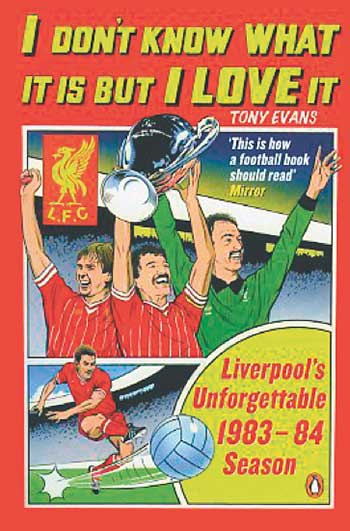 Liverpool’s unforgettable 1983-84 season
Liverpool’s unforgettable 1983-84 season
by Tony Evans
Penguin, £9.99
Reviewed by Jonathan Paxton
From WSC 343 September 2015
On paper Liverpool’s 1984 treble winners were a surprisingly ordinary side. Even with Graeme Souness, Ian Rush and an occasionally fit Kenny Dalglish, this was a team in transition under new manager Joe Fagan, one that could lose 4-0 at Coventry and in which Michael Robinson could hold down a regular place. Tony Evans, a Liverpool fan who attended nearly all the games that season, holds them in higher regard than the statistically superior and more skilful sides of either 1979 or 1988 and his adoration shines through, if sometimes a little too brightly.
An experienced journalist, at the Times until recently, Evans writes from the perspective of an ardent fan of both club and city. The book’s title (an obscure Chris Rea track, apparently popular only in the Anfield dressing room) and the cover artwork suggest a nostalgic, feel good story but despite the team’s success, attendances are low and the city is struggling economically. Some interesting social and political asides featuring Derek Hatton and Margaret Thatcher are touched upon but the book’s focus never strays far from football.
Through interviews with team members, we find a mainly happy squad but a social group with a heavy drinking culture that new signings and reserve players find daunting. The much eulogised bootroom is presented as dingy with paint flaking off the walls and around the training ground there is an atmosphere of intimidation that sometimes approaches bullying. New boy Craig Johnston is ridiculed for his diet and fitness regime and, in one of the book’s most interesting sections, his failure to hold down a first-team place pushes him close to a breakdown. Meanwhile, Alan Kennedy’s happy-go-lucky attitude seems to be what cements his position in the side and Fagan struggles to shape a midfield to cover the clumsy defender without ever considering a replacement left-back.
Fagan himself remains an elusive enigma, mainly because the manager was so private and reluctant to speak to the media. His is clearly respected by his players and a good motivator, yet we don’t get the impression he had the wit or tactical insight to compare with his predecessors Bill Shankly and Bob Paisley. Even through quotes from his diary we struggle to get to know Fagan the man. Entries such as “Well the lads did it, each one deserved a medal” suggest that he was dull and unimaginative.
Evans does tell a good story and undoubtedly loves his subject. Sometimes though rambling quotes from players can be overlong and struggle to explain a point clearly, and when the squad travel to Denmark the journalist in Evans can’t resist a Hans Christian Andersen/fairytale analogy. At points it reads like a hagiography of the team, particularly Souness who kicks and punches his way through matches but is lifted to the status of demi-god by the author. Like Souness, this book may not be universally popular outside of Anfield but it stands as an interesting if rose-tinted review of what was a very successful team.